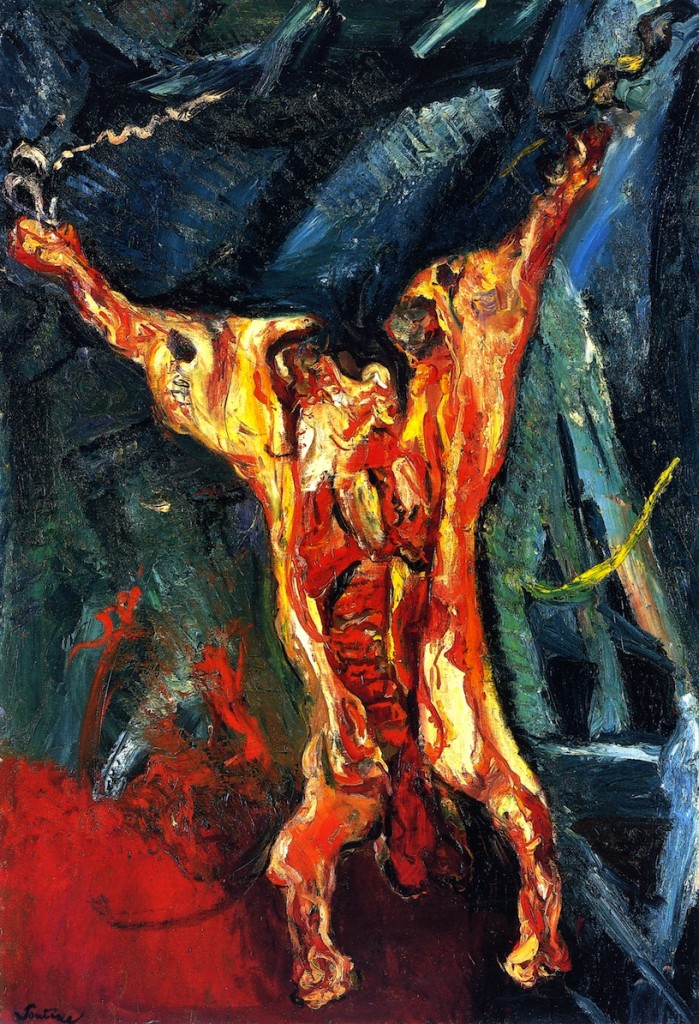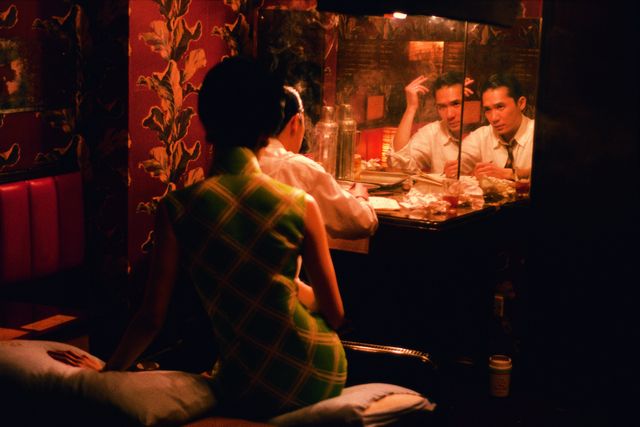There’s this story.
In the 1920’s Marc Chagall stood in the corridor of a Parisian flat––riveted––as blood leaked out from the rooms of Chaim Soutine. Overtaken by fear Chagall vaulted out of the building shouting,
“Someone has killed Soutine!”
“Someone has killed Soutine!”
The blood came from an animal carcass that Soutine was painting. It was to be a series of 10.

Why Soutine?
Because when I look at a carcass by Soutine I see the films of Wong-Kar Wai.


Blood brothers?
While Soutine flouted moral hygiene and the aesthetic of art at the turn of the century Wong… is a different generation. A Hong Kong filmmaker whose family immigrated from the Mainland as part of the diaspora of the 50’s and 60’s, Wong’s films, though not always set in Hong Kong, maintain a great affinity for the drifting island. Grounded in a sort of melancholy ephemerality of place, Wong’s work is always filled with longing and lost memories, places that are incomplete, an everlasting homage to the floating mass that drifts between East and West.
So the painter & the filmmaker are not blood brothers. Yet they share a visual affinity, a congealing of the arts where the mind feeds the aesthetic with a kind of visceral hemorrhage of color. For both the palette is power and as a result the subject blooms in the same moment as it undergoes a sort of decay. What makes Wong a filmmaker and not a painter is that color is not restricted to the visual canvas:
[…] Music is like a color.
It is like a filter that tints everything in a different shade.
-Wong-Kar Wai
Wong is faithful to this credence—at least I think so. I have no fixed connection with the films of Wong-Kar Wai, no inbred empathy for his stories or the individuals who people them, as Nick Ray once said, “I am a stranger here myself”. Still, a chance encounter with the music alone has a tendency to trigger in me an entire city of emotion. When I watch a film I feel that I possess only what I came with and only what I am given, and Wong is a very giving director. He’s inclined to believe that our natural experience of the sound is just as sincere as that of the image. They’re partners and each film is a tango, saturated not just by color but by the color of sound.
It’s hard to pin-point the crux of my devotion to Wong’s oeuvre but for some reason, light-minded or with heartache, I am always In the Mood for Love.
In the Mood for Love (2000) is a film that makes cinema worthwhile. It’s a testament to time, forgotten space and love stuck. A story of a love affair and the pretense of a love affair. Like many of Wong’s film’s there’s an element of a personal history. A lot of the music we hear is what Wong himself heard on the radio as a child growing up in Hong Kong. Nat King Cole, Rebecca Pan, Peking and Cantonese Operas, Shanghai Pop songs, a culture of sounds from East and West, mixed together on an island that floats precariously between the two. The images are ordinary in the sense that life in the world of the two pretend lovers is ritual and solitary. Even the most simple activities like partaking in a meal somehow trap characters in a cycle of loneliness. The resulting mixture of image and sound conjures passion as the mundane. Heat as pure heat and something else entirely, a tension incarnated by the bodies that front the screen.
There’s this scene…
Su Li-Zhen’s husband “works” late. She can’t stand to cook only for herself, so, night after night she makes the same trip to the noodle vedor. The evening heat is as unbearable as the act of eating alone. These two thoughts haunt her every night.
Su Li-Zhen, played by Maggie Cheung, is a character whose nightly journey is branded by a particular piece of music, Shigeru Umebayashi’s Yumeji’s Theme, a composition which becomes an enchanting and desolate anthem. The sequence is fairly mundane, the only actions that seem permisible are those committed by the body almost involuntarily. Li-Zhen at times is merely a puppet on strings, propelled through the motions of habitual life. And yet she is always dressed in a vibrant cheongsam, a gown both modest in form and also purely carnal in color. The dress is a visual manifestation of Su Li-Zhen’s conflicted nature, a combination of suppressed desire and uncontrollable longing, an image reverently echoed by the music. Li-Zhen’s lonesome procession is haunting and this effect is nurtured by the music which seems capable of slowing down time itself. A music that lingers in a moment that seems to be lost, already past, just a memory of time.
As Su Li-Zhen ascends the staircase from the noodle stall she runs into her neighbor Chow Mo-Wan (Tony Leung). The two objects of desire meet in the narrow folds of the alley and the music transfers to Mo-Wan, bearing with him through his own solitary meal–––his wife also “works” late. The manipulation of image through sound colors both Su Li-Zhen and Chow Mo-Wan as characters full of missed chances and bottled yearning. However, Yumeji’s Theme seems intimately tied Su Li-Zhen. She is the unerring initiator of the melody as well as the character who is more heavily weighted by the solitude of her obligations. She is the physical incarnation of Yumeji’s Theme–––a river of sound set on fire, slowly searing the spirit, ours and Chow Mo-Wan’s. Never fulfilled, always repeating, a visual entrapment echoed and reverberated by the efforts of music and image, so full of want, so stuck.
